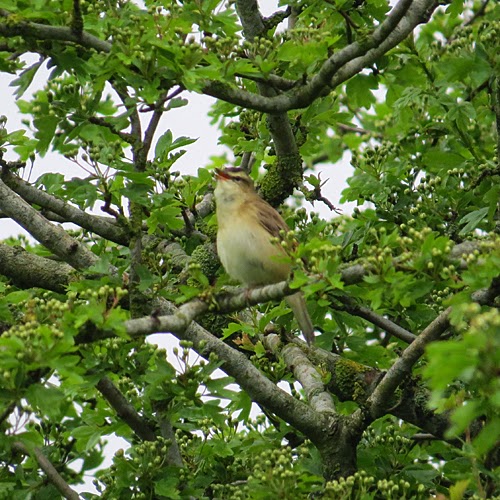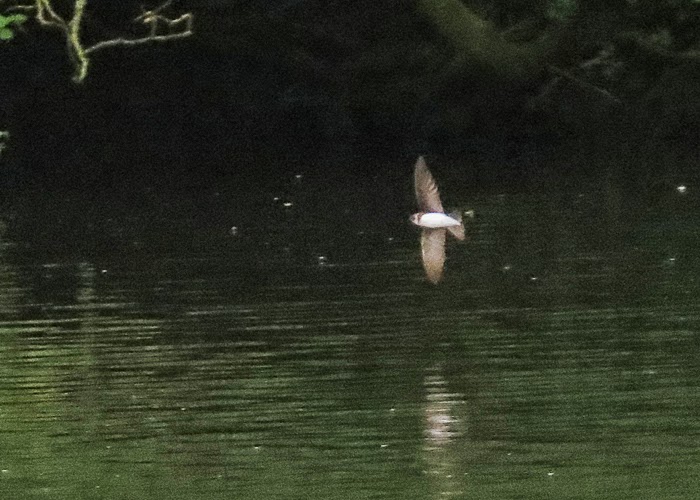As forecast the fog lifted at 10:00am and I arrived at the Car Park for 10:15am. With the heavy rain we'd had I decided wellies were in order, which was just as well, as it was pretty boggy in places. A Willow Warbler greeted me as I got the car and as I headed up the path a Carrion Crow was mobbing a Buzzard as it attempted to fly east. A Blackcap was singing from the hedgerow on my right and for a brief second popped up on a branch in front of me before disappearing into the bushes.
Another Willow Warbler was singing around by the Pylons close to the bungalows and also there was a Chiffchaff, Lesser Whitethroat, another Blackcap and Garden Warbler, which obligingly flew up into the Ash Tree and started singing. More often or not they're heard singing inside a hedge and really in the open.
Garden Warbler
In good voice
Further on a Common Whitethroat began singing and as I passed the bungalows, I was suddenly aware that all around me there were dozens of St Mark's Flies emerging. They were everywhere and they weren't alone as there were also many Drone Flies in amongst them.
St Mark's Fly
Drone Fly
The track I was on runs up to Kingsdown Lane and as I reached it the sun had warmed up the ground so much that there were butterflies everywhere. Orange-tips, Brimstones and Green-veined Whites. It didn't matter where you looked there would be one next to you. Also on the flowers were lots of Bee-flies and Bumblebees.
Bumblebee
Orange-tip in flight
Orange-tip
Orange-tip in flight
A male Brimstone
Green-veined White
Peacock Butterfly
Scorpion Fly
So feeling a little deflated I threaded my way through the hawthorns and followed the deer tracks back towards Kingsdown Lane. After several minutes I eventually popped out of the bushes onto the path. As I did so a Holly Blue passed me by.
In the past I've normally followed the path back round towards the A419, but I have often seen dog walkers heading off north by following a trail through another copse just in front of me. By following the track, you go through the woods until it comes out onto a meadow. And what a sight it was, there were Cowslips covering the whole field. It was like a sea of yellow as far as the eye could see. Quite impressive, especially when the sun came out. I followed the edge of the wood and came across another Willow Warbler singing his heart out on the uppermost branches of a Silver Birch. At times he took off and was still singing as he was flying to another song post. Well I can honestly say I've not seen that before!
Willow Warbler
Willow Warbler
Willow Warbler
Willow Warbler
Willow Warbler
In the wood, just behind where the Willow Warbler was singing, there was right commotion going on with Blackcaps, Blackbirds and other birds all scolding something in the bushes. Being inquisitive I followed another deer trail into the wood to see what all the fuss was about. By the time I'd walked 10 metres in, whatever it was had gone. However to my amazement there was a Sedge Warbler singing from the Hawthorn Bush next to me, in a Wood! I walked around to the back of the bushes and realised that on the other side was Kingsdown Lane again. As I popped out onto the lane, the Sedge Warbler obviously saw me and flew about 20ft down the lane before flying back into the wood. Really bizarre, the only thing I can think of is that it's using the lane as a navigational aid before heading off to its breeding ground. Or is it nesting at Stratton Wood! Who knows, but I certainly wasn't expecting that!
By walking west from this point I passed a second meadow, which was also covered with Cowslips, and eventually ended up walking south and parallel with the A419. There were a few more butterflies along here including a Peacock that alighted on a rock when the sun went behind a cloud. It stayed there for a few minutes, no doubt warming his body from the heat being held in the rock. When the sun came out again he was gone. I came across another bee which I think is a Lasioglossum leucozonium. Trouble is there are so many look alikes, that all I'm going to say is, this is a probable.
The busy A419 is to the right. In the distance is Liddington Hill
Peacock
Possible Lasioglossum leucozonium.
My walk was nearly drawing to an end and as I joined the gravel path, I heard a familiar sound coming from within the middle of the brambles and hawthorns. It was a male House Sparrow chirping away non-stop. I can only assume that he and his mate are nesting in the bushes. Well yet again I wasn't expecting that!
A male House Sparrow chirping away in the middle of these Bushes
After 2 hours I eventually ended up close to the car park and managed to photograph a female Brimstone which at first glance I thought was a Large Cabbage White. Having seen a Cabbage White earlier I very nearly ignored this one. It was only when it landed I suddenly realised it was a female Brimstone, they really are pale compared to the males.
A female Brimstone
And another Green-veined White
Birds Recorded today were: Buzzard, Wood Pigeon, Collared Dove, Feral Pigeon, Green Woodpecker, Great Spotted Woodpecker, Skylark, Dunnock, Robin, Blackbird, Song Thrush, 1 Sedge Warbler, 2 Garden Warbler, 3 Common Whitethroat, 1 Lesser Whitethroat, 7 Blackcap, 7 Chiffchaff, 7 Willow Warbler, Long-tailed Tit, Great Tit, Blue Tit, Wren, Magpie, Rook, Carrion Crow, Jackdaw, Starling, 1 House Sparrow, Chaffinch, Linnet, Goldfinch, Greenfinch and Bullfinch.
Butterflies seen were: Orange-tip, Peacock, Brimstone, Small Tortoiseshell, Green-veined White, Large Cabbage White and Holly Blue.
Insects seen were: St Mark's Fly, Drone Fly, Bee-fly, Common Wasp and possibly a Lasioglossum leucozonium.
Mammals seen: 5 Rabbits and a Grey Squirrel























































